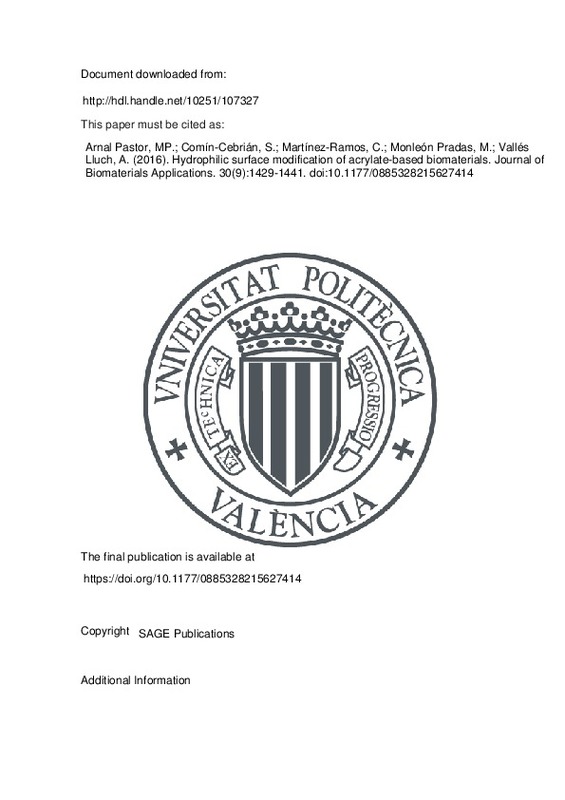JavaScript is disabled for your browser. Some features of this site may not work without it.
Buscar en RiuNet
Listar
Mi cuenta
Estadísticas
Ayuda RiuNet
Admin. UPV
Hydrophilic surface modification of acrylate-based biomaterials
Mostrar el registro sencillo del ítem
Ficheros en el ítem
| dc.contributor.author | Arnal Pastor, María Pilar
|
es_ES |
| dc.contributor.author | Comín-Cebrián, S.
|
es_ES |
| dc.contributor.author | Martínez-Ramos, C.
|
es_ES |
| dc.contributor.author | Monleón Pradas, Manuel
|
es_ES |
| dc.contributor.author | Vallés Lluch, Ana
|
es_ES |
| dc.date.accessioned | 2018-09-17T06:52:37Z | |
| dc.date.available | 2018-09-17T06:52:37Z | |
| dc.date.issued | 2016 | es_ES |
| dc.identifier.issn | 0885-3282 | es_ES |
| dc.identifier.uri | http://hdl.handle.net/10251/107327 | |
| dc.description.abstract | [EN] Acrylic polymers have proved to be excellent with regard to cell adhesion, colonization and survival, in vitro and in vivo. Highly ordered and regular pore structures thereof can be produced with the help of polyamide templates, which are removed with nitric acid. This treatment converts a fraction of the ethyl acrylate side groups into acrylic acid, turning poly(ethyl acrylate) scaffolds into a more hydrophilic and pH-sensitive substrate, while its good biological performance remains intact. To quantify the extent of such a modification, and be able to characterize the degree of hydrophilicity of poly(ethyl acrylate), poly(ethyl acrylate) was treated with acid for different times (four, nine and 17 days), and compared with poly(acrylic acid) and a 90/10%wt. EA/AAc copolymer (P(EA-co-AAc)). The biological performance was also assessed for samples immersed in acid up to four days and the copolymer, and it was found that the incorporation of acidic units on the material surface was not prejudicial for cells. This surface modification of 3D porous hydrophobic scaffolds makes easier the wetting with culture medium and aqueous solutions in general, and thus represents an advantage in the manageability of the scaffolds. | es_ES |
| dc.description.sponsorship | The author(s) disclosed receipt of the following financial support for the research, authorship, and/or publication of this article: The authors acknowledge financing through project FP7 NMP3-SL-2009-229239 'Regeneration of cardiac tissue assisted by bioactive implants' (RECATABI) and projects MAT2011-28791-C03-02 and -03 from the Spanish Ministerio de Ciencia e Innovacion. This work was also supported by the Spanish Ministry of Education through M. Arnal-Pastor FPU AP2009-1870 grant. | en_EN |
| dc.language | Inglés | es_ES |
| dc.publisher | SAGE Publications | es_ES |
| dc.relation.ispartof | Journal of Biomaterials Applications | es_ES |
| dc.rights | Reserva de todos los derechos | es_ES |
| dc.subject | Scaffold | es_ES |
| dc.subject | Nitric acid | es_ES |
| dc.subject | Ethyl acrylate | es_ES |
| dc.subject | Acrylic acid | es_ES |
| dc.subject | Surface modification | es_ES |
| dc.subject.classification | MAQUINAS Y MOTORES TERMICOS | es_ES |
| dc.subject.classification | TERMODINAMICA APLICADA (UPV) | es_ES |
| dc.title | Hydrophilic surface modification of acrylate-based biomaterials | es_ES |
| dc.type | Artículo | es_ES |
| dc.identifier.doi | 10.1177/0885328215627414 | es_ES |
| dc.relation.projectID | info:eu-repo/grantAgreement/ME//AP2009-1870/ES/AP2009-1870/ | es_ES |
| dc.relation.projectID | info:eu-repo/grantAgreement/EC/FP7/229239/EU/Regeneration of Cardiac Tissue Assisted by Bioactive Implants/ | |
| dc.relation.projectID | info:eu-repo/grantAgreement/MICINN//MAT2011-28791-C03-02/ES/MATERIALES DE SOPORTE Y LIBERACION CONTROLADA PARA LA REGENERACION DE ESTRUCTURAS NEURALES AFECTADAS POR ICTUS/ | es_ES |
| dc.relation.projectID | info:eu-repo/grantAgreement/MICINN//MAT2011-28791-C03-03/ES/CONSTRUCTOS PARA LA REGENERACION GUIADA DE ESTRUCTURAS DEL SISTEMA NERVIOSO CENTRAL/ | es_ES |
| dc.rights.accessRights | Abierto | es_ES |
| dc.contributor.affiliation | Universitat Politècnica de València. Departamento de Termodinámica Aplicada - Departament de Termodinàmica Aplicada | es_ES |
| dc.description.bibliographicCitation | Arnal Pastor, MP.; Comín-Cebrián, S.; Martínez-Ramos, C.; Monleón Pradas, M.; Vallés Lluch, A. (2016). Hydrophilic surface modification of acrylate-based biomaterials. Journal of Biomaterials Applications. 30(9):1429-1441. https://doi.org/10.1177/0885328215627414 | es_ES |
| dc.description.accrualMethod | S | es_ES |
| dc.relation.publisherversion | https://doi.org/10.1177/0885328215627414 | es_ES |
| dc.description.upvformatpinicio | 1429 | es_ES |
| dc.description.upvformatpfin | 1441 | es_ES |
| dc.type.version | info:eu-repo/semantics/publishedVersion | es_ES |
| dc.description.volume | 30 | es_ES |
| dc.description.issue | 9 | es_ES |
| dc.relation.pasarela | S\299618 | es_ES |
| dc.contributor.funder | Ministerio de Educación | es_ES |
| dc.contributor.funder | European Commission | es_ES |
| dc.contributor.funder | Ministerio de Ciencia e Innovación | es_ES |







![[Cerrado]](/themes/UPV/images/candado.png)

